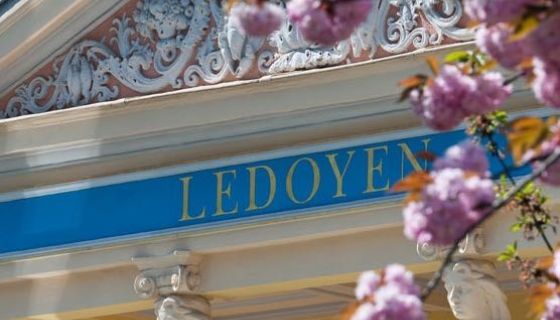As we walked out on to the Champs-Élysées after dinner at Pavillon Ledoyen we were left wondering about two quite different matters.
The first was quite how long the taste and aroma of the exquisite mango would last in our mouths. It had been served about 45 minutes earlier as our dessert, roasted, accompanied by meringue and served with a syrupy vinegar made from mangoes and pears. We could still taste it as we walked into Concorde metro.
The second was what exactly would the new Ledoyen look like after it closes at the end of this year. In what will be its first major refurbishment in over 200 years – the restaurant takes its name from Pierre-Michel Doyen, scion of a well-known family of traiteurs, who opened here in 1791 and counted Robespierre, Danton and Marat among their clients – this prestigious restaurant has since 2014 been home to chef Yannick Alléno.
These changes were explained to me in outline by Frédéric Pedrono, the restaurant’s director, who has been at Ledoyen for over 10 years. Basically, the roles of the ground and first floors will be reversed. The restaurant that has occupied the first floor and has views of the Petit Palais will in the new design be on the ground floor while the first floor will be broken up into a series of private dining rooms.
Such a transformation of an elegant, 18th-century building will be time-consuming and costly. The intricacy of the ceiling and wall fittings will, I feel sure, occupy the minds of many a bureaucrat but Alléno, a chef not nearly as well known in the Anglo-Saxon world as in France and Asia, appears to have the energy as well as the backing to pursue this to the finish.
Born in France, Alléno garnered three Michelin stars at Le Meurice in Paris before embarking on a consultancy role that has seen restaurants bearing his name open in Morocco, Dubai, Beijing and Taiwan. Since his takeover of Ledoyen, he was awarded the same high rating in 2015.
I was fortunate enough to eat twice at Le Meurice during the Alléno era and noticed on the second occasion certain significant changes in Alléno’s style. It has become more intricate and more complex. He seems to rely less on the provenance of his suppliers and more on the hard work, dexterity and high level of culinary competence that he demands of his chefs. Several of the dishes we ate recently, I would not advise any cook, however competent, to try to replicate at home.
The professionalism of the kitchen is matched by the front of house team. Under Pedrono’s guidance they – predominantly young men in smart suits plus one Japanese woman – answered all our questions confidently; they knew the nascent wine list inside out; and passed on this knowledge effortlessly and without the condescension that can be all too common in three-star establishments.
They start with one great advantage that I trust will be incorporated in the redesign. Pedrono and his team are gathered at the top of the stairs as much, I realised subsequently, to guide you to your table as to enjoy the rich, inviting smells emanating from the kitchen just off this landing.
As the menu was presented, along with four amuse-bouches that included a fine taste of sweet onion soup topped with a melted Comté crisp, it revealed a particular surprise. On the left-hand side, where normally the first courses would be listed, are instead the six main courses. Alléno, in contrast to many top chefs who put their energy into what will immediately excite the customer’s palate, believes that choosing the main course will determine the invariably more refined first course.
In fact, there was little to choose between the intricate execution of each of our three courses although perhaps the first was the most complex. This consisted of the inside shell of a grapefruit that had been burnt to a dark brown and contained a soup made from sea urchins. Alongside it was a warm fork on which was perched a crisp piece of duck skin on which was placed a thin piece of foie gras. This was to be eaten first and then, we were politely instructed, we were to take sips of the soup alongside sips of cool grapefruit, which was served in a separate dish, topped with mouthfuls of fresh sea urchin. This was an exercise in temperature, bitterness, texture and the ultimately highly successful combination of some remarkably unlikely ingredients.
Our main courses took us to the south and east of France. Lobster came as a fricassee, topped with leaves of Chinese cabbage, enlivened with what was described as a ‘sauce moderne’, Alléno’s distinctive method of finishing a dish that incorporates more an extraction of ingredients rather than a conventional sauce. The fillet of venison was roasted simply but served unconventionally in a birch log, from which it was taken out and sliced. Its accompaniments ranged from an anchovy sauce to a tart of cardoons and some perfectly confited, tiny shallots.
My bill came to 467 euros that included 167 euros on a glass each of Austrian Riesling Smaragd 2013 (31 euros) from Emmerich Knoll and Les Granits 2011 St-Joseph from Michel Chapoutier (36 euros) and a bottle of Grenache from Domaine de Montcalmès 2011 (100 euros) in the Languedoc.
I honestly considered this to be money extremely well spent.
Pavillon Ledoyen Carré des Champs-Élysées, 1 avenue Dutuit, 75008 Paris; tel +33 (0)1 53 05 10 00














